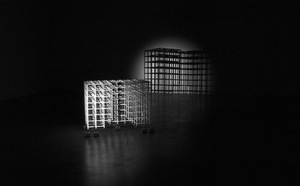Artist Insights: Jan Tichy


Born in Prague, artist Jan Tichy lives and works in Chicago and teaches at the School of the Art Institute (SAIC). This fall, several impressive projects coincide at area art institutions throughout Chicago at the Museum of Contemporary Photography (MoCP), the Museum of Contemporary Art (MCA), Expo Chicago, the Art Institute of Chicago, and Richard Gray Gallery. CGN's Laura Miller met with Tichy to hear about all that's happening for the artist-educator this season.
LM: Tell me about working with the Museum of Contemporary Photography for the past year on a project involving their collection.
JT: Last year MoCP curator Karen Irvine asked me to consider new ways of interpreting their collection of more than 12,000 images and to create an exhibition that would explore it from a different perspective. MoCP was one of the first museums to upload digital images of their collection to their website as a way to connect with the public. I realized soon that the access and search tools are quite inappropriate for an interaction with this amazing digital archive. So, I considered ways to improve the access to the online collection and decided to create a think tank of Chicago MFA students (Columbia College, SAIC, UofC, UIC) that would bring updated perspectives on how to identify and develop strategies for better online interaction. We introduced applications, web design strategies and interactive elements that will hopefully give better access to a greater community.
While coming to work at MoCP I realized that the museum itself is not really accessible/ visible from the street, despite its prominent Michigan Avenue location; many Chicagoans don't even know about it. So, I proposed to establish a digital gallery on the outside of the museum. Two large monitors will be installed on MoCP's exterior walls at the corner of Michigan and Harrison. The digital galleries will display exhibitions from the collection, curated specifically for that purpose by a wide range of curators from around the world. My exhibition there this fall will explore the collection using my own time-based tool of video and projection and will hopefully expose some hidden jewels.
What else can we expect from you this fall?
At Expo Chicago I'm really excited for the U.S. premier of Things to Come (1936-2012), a three-channel video installation made from 80 seconds of never before exhibited film footage that Laszlo Moholy-Nagy created in 1936 in London. H.G. Wells commissioned Moholy-Nagy when working on an exhibition design for his show at Loyola University Museum of Art three years ago. It took me sometime to realize the potential hidden in these film snippets; using Moholy-Nagys analog techniques in digital media with the initial H.G. Wells criteria, I hope to bring new life to it.
I have older works in group-exhibitions this fall at the Museum of Contemporary Art and Richard Gray Gallery. For the Art Institute of Chicago's Ando Gallery, I'm working on a site specific installation to coincide with an exhibition of contemporary Japanese garments from SAIC's Fashion Resource Center. Outside of Chicago I'll be participating in this fall's Architecture Biennale in Venice in the Israeli Pavilion and working with No Longer Empty in NYC.
You've been involved in several large-scale collaborative projects with local college students, community members, and art institutions—2011's powerful Project Cabrini Green, 2009's Lighting the Crown Hall at the IIT, now the MoCP project, among others. How do these collaboration evolve?
As an artist and educator I believe in a creative collaboration between faculty and students as one of the models of successful art education, a theory that Moholy-Nagy was practicing in Chicago 60 years ago. I also share the belief, formulate and practiced by curator and educator Mary Janes Jacobs, that in the contemporary art world, art school offer a great platform to develop professional art productions. Project Cabrini Green is a good example of how this model benefits students, the institution and the community as well as an artist and a commercial gallery. The project required huge amounts of time and involvement. Together with Efrat Appel we collaborated with 25 dedicated students and faculty from SAIC to develop and create all the different layers of the project and worked with over 100 teenagers from four after school programs in Cabrini Green to create the content. It wouldn't be possible without the active support of Richard Gray Gallery and the administration of SAIC. Including the MCA and CHA there were over 200 people involved in the project.
How did you make the transition to Chicago?
It was actually very easy, maybe because I moved from Prague to Jerusalem when I was 19. During my MFA studies at Bezalel Academy of Art and Design in Tel Aviv, I participated in a collaborative project in Helsinki initiated by SAIC. Eventually I was accepted to their Sculpture program. I finished my MFA at SAIC in 2009 and stayed to teach at the Department of Art and Technology Studies. I fell for Chicago from the beginning, and the city was kind to me. I had the extraordinary opportunity to create projects for a few signature buildings like Crown Hall, the Hancock, Spertus, Montgomery Ward, and Cabrini Green. There are more under way (Chicago Cultural Center in 2014.)
After living, working, and exhibiting around the world, how do you find Chicago for art?
The way Chicago is built—physically, socially, and culturally—there's space and opportunities for many cultural activities, and plenty of people want to do things. I serve on advisory boards of ACRE and threewalls, non-profits that provide the local art community with accessible spaces and rich programming. These organizations, like many other independent art spaces, apartment and pop-up galleries, are the vital source of culture for the community and an important spawn of the next generation of cultural producers.






